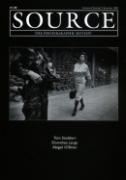Angels in the Architecture
Images of Sarajevo's Children by Louis Jammes were on display in Dublin's Temple Bar, 1996
Review by Paul M. O'Reilly
Issue 8 Summer 1996
View Contents ▸
"We are born into a world where alienation awaits us. We are potentially men (and women), but are in an alienated state, and this state is not simply a natural system. Alienation as our present destiny is achieved only by outrageous violence perpetrated by human beings on human beings". R.D. Laing's The Politics of Experience (1967) documents some forms of our contemporary violation of ourselves. The images of Sarajevo's children by the photographer Louis Jammes, fifteen of which rose like apparitions to hover in and around Dublin's Temple Bar, can be understood as further evidence of our predicament
Jammes began his campaign in the ruins of Sarajevo. He photographed children in a full-length, frontal format and then imposed on the image tones, shapes, tones and textures that gave each child in a vague, mysterious way the benefit of wings to produce a haunting hybrid of child and angel. When printed to mural size and fixed directly to inside and outside surfaces of war devastated buildings in Sarajevo they became apparitions, ghosts, spectres, whose sudden unexpected appearance is meant to catch the conscience of passers-by. A published book of these works shows the power of these angels in the Sarajevo context. These children presented as war-torn survivors regard Jammes, and by extension ourselves as passers-by, with a gentle, attentive and unassuming gracefulness. They seem subdued, watchful, expectant and fully absorbed in the camera's fixed moment. Jammes' graphic alterations emphasise their isolation and add a sense of the monumental and momentous.
These images judiciously placed on the not-yet or as-yet to be ruined walls of Temple Bar serve to twin Sarajevo and Dublin. The forces that have surfaced and raged in Sarajevo are hidden but present everywhere. Temple Bar doesn't have to be bombed into physical destruction as have many parts of Derry and Belfast to be understood to have a sense of ruin, on the mind and in the heart. And it's not only glib and righteous politicians who can apply the analogy of the Bosnian/Serb/Croat divide to the alienation that destroys our own country. These angels of reproach brought to us by Jammes belong here, too. They remind us that we are ourselves guilty bystanders. Or they can and will remind us if we have the presence of mind to listen to what Jammes has to say and tease out the meanings for which his work offers us evidence and clues.
To release work from the spaces of books and galleries and insert it into the free-for-all urban environment is an attempt increasingly made by artists who are anxious to deal as directly as possible with as many people as possible over issues, themes and emotions in a discourse they believe is important to us all. They no longer want to entrust their art solely to a specialised and often jaded audience.
By reaching into a public world for a position from which they can have their say and hope to gain attention of listeners they must compete with the cacophony of text and image that smothers the commercial, consumer environment. This is not an easy thing to do. Most of the public seems to move through public spaces in a daze of blatant and blunted self-interest, all the more routinely standardised despite its devotion to the individual. The Me. As it was, is now, and ever shall be. Amen. Of course it's an illusion. The Me is exactly what is under threat of annihilation. All the Me's are alienated and the resulting outrageous violence that so shook R. D. Laing is what Jammes wants us to take heed of.
Each of us is still a child or has the potential to be one again. Each of us may even be in some strange way that hybrid that Jammes found in Sarajevo and brought to Dublin. The world is full of angels who but for art remain the silent and invisible witnesses to the struggle that destroys us.






